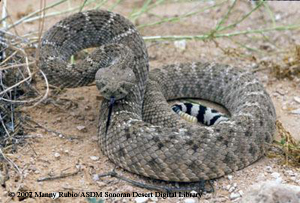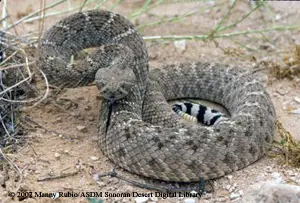Western Diamondback Rattlesnakes are known for their iconic rattle and venomous bite, but are they endangered? These snakes are found in the southwestern United States and parts of Mexico, but their population has been decreasing due to habitat loss and human interference.
Despite being a resilient species, Western Diamondback Rattlesnakes are facing threats such as illegal poaching, habitat destruction, and climate change. As their population continues to decline, it is crucial to understand the current status of these snakes and take measures to protect them for future generations to appreciate.
Western Diamondback Rattlesnakes are not currently listed as an endangered species. However, they are considered a threatened species in some states due to habitat loss and overhunting. It is important to note that while their populations may not be in immediate danger, conservation efforts should still be made to protect these important predators and maintain a healthy ecosystem.

Are Western Diamondback Rattlesnakes Endangered?
Western Diamondback Rattlesnakes are one of the most recognizable and feared snakes in the United States. They are found in the southwestern US and are known for their large size and distinctive diamond-shaped markings. Despite their notoriety, many people are unaware of the true status of this species. Are Western Diamondback Rattlesnakes endangered? Let’s take a closer look.
Population and Habitat
Western Diamondback Rattlesnakes are found throughout the southwestern United States, from California to Texas. They prefer arid and semi-arid habitats, such as deserts, grasslands, and scrublands. These snakes are often found in rocky areas, where they can hide and bask in the sun. However, they are also known to live in urban areas, where they can find shelter in buildings and under debris.
Despite their widespread distribution, Western Diamondback Rattlesnakes are facing threats to their population. Habitat loss and fragmentation are major concerns, as more and more land is developed for human use. Additionally, these snakes are often killed by humans out of fear or for their skin and meat. This has led to declines in some populations and could eventually lead to the species becoming endangered.
To protect Western Diamondback Rattlesnakes, it is important to preserve their habitat and educate the public about their importance in the ecosystem.
Ecological Importance
Western Diamondback Rattlesnakes play an important role in their ecosystems. They are top predators and help to control populations of rodents, rabbits, and other small animals. Without these snakes, these prey species could become overpopulated and cause damage to the environment. Additionally, Western Diamondback Rattlesnakes are preyed upon by other animals, such as hawks, eagles, and coyotes. Their presence in an ecosystem provides food for these predators.
Furthermore, Western Diamondback Rattlesnakes are important indicators of ecosystem health. Their presence or absence can indicate changes in the environment, such as pollution or climate change. By monitoring populations of these snakes, scientists can gain insight into the health of entire ecosystems.
Conservation Efforts
To protect Western Diamondback Rattlesnakes, several conservation efforts are underway. The US Fish and Wildlife Service has designated the species as a “species of concern,” which means that it is not yet endangered but could become so if action is not taken. Additionally, some states have implemented regulations to protect these snakes, such as prohibiting the collection or sale of them.
One of the most important conservation efforts is habitat preservation. Several organizations are working to protect and restore the habitats of Western Diamondback Rattlesnakes. This includes setting aside land for conservation, restoring degraded habitats, and promoting sustainable land use practices.
Another important conservation effort is education. By educating the public about the importance of Western Diamondback Rattlesnakes, we can reduce the number of snakes killed out of fear or ignorance. Additionally, education can help to promote conservation efforts and encourage people to take action to protect these snakes and their habitats.
Benefits of Western Diamondback Rattlesnakes
Western Diamondback Rattlesnakes may seem scary, but they provide several benefits to their ecosystems and to humans. As top predators, they help to control populations of small animals, which can prevent damage to crops and other plants. Additionally, their venom has potential medical uses, such as in the development of painkillers and blood thinners. Finally, these snakes are an important part of the natural heritage of the southwestern United States and are an important part of the ecosystem.
Conclusion
So, are Western Diamondback Rattlesnakes endangered? While they are not currently listed as endangered, they are facing threats to their population due to habitat loss, fragmentation, and human persecution. By taking action to protect their habitats and educate the public about their importance, we can ensure that Western Diamondback Rattlesnakes continue to thrive in the southwestern United States.
Frequently Asked Questions
Here are some common questions and answers about the Western Diamondback Rattlesnake and their conservation status.
What is the Western Diamondback Rattlesnake?
The Western Diamondback Rattlesnake is a venomous snake found in North America. They are known for their distinctive diamond-shaped pattern on their back and their rattle at the end of their tail. They are one of the most common species of rattlesnake in the United States.
Although they can be dangerous to humans, Western Diamondback Rattlesnakes play an important role in the ecosystem by controlling rodent populations. It is important to respect these animals and give them the space they need to thrive.
What is the conservation status of the Western Diamondback Rattlesnake?
The Western Diamondback Rattlesnake is not currently listed as an endangered species. However, some populations may be threatened by habitat loss and fragmentation, as well as human persecution. It is important to protect their habitats and educate people about their importance in the ecosystem.
If you encounter a Western Diamondback Rattlesnake in the wild, it is important to keep a safe distance and avoid disturbing them. If you live in an area where rattlesnakes are common, take steps to make your property less attractive to rodents, which can attract snakes.
What threats do Western Diamondback Rattlesnakes face?
The main threats to Western Diamondback Rattlesnakes are habitat loss and fragmentation, as well as human persecution. As more land is developed for agriculture and urbanization, rattlesnake populations may become isolated and unable to move between habitats. Additionally, people often kill rattlesnakes out of fear or misunderstanding, which can further reduce their populations.
To protect Western Diamondback Rattlesnakes, it is important to preserve their habitats and educate people about their importance in the ecosystem. If you encounter a rattlesnake, give it the space it needs and avoid disturbing it.
What can be done to conserve Western Diamondback Rattlesnakes?
To conserve Western Diamondback Rattlesnakes, we need to protect their habitats and educate people about their importance in the ecosystem. This includes preserving natural areas, reducing habitat fragmentation, and creating wildlife corridors to connect isolated populations.
We also need to educate people about how to live safely with rattlesnakes. This includes keeping your property free of rodents, which can attract snakes, and being mindful of your surroundings when hiking or working outdoors. If you encounter a rattlesnake, give it the space it needs and avoid disturbing it.
Why are Western Diamondback Rattlesnakes important?
Western Diamondback Rattlesnakes play an important role in the ecosystem by controlling rodent populations. Without rattlesnakes, rodent populations could explode, leading to a variety of problems including damage to crops and the spread of disease. Additionally, rattlesnakes are important prey for many other animals, including birds of prey and larger mammals.
Although they can be dangerous to humans, Western Diamondback Rattlesnakes are an important part of the natural world and deserve our respect and protection.
This Snake Needs SERIOUS Help! – Why Eastern Diamondback Rattlesnakes Are “Endangered”!
In conclusion, the Western Diamondback Rattlesnake is currently not classified as an endangered species. However, the threats to their population, such as habitat destruction and human persecution, cannot be ignored. It is important to continue monitoring their population and habitat to ensure their survival and prevent them from becoming endangered in the future.
Although the Western Diamondback Rattlesnake is not currently endangered, it is still an important and valuable species in its ecosystem. They play a crucial role in controlling rodent populations and maintaining the balance of their ecosystems. Therefore, it is essential to protect their habitat and minimize human impact on their populations.
In the end, it is up to us to take responsibility for the conservation of the Western Diamondback Rattlesnake and other wildlife species. By raising awareness, supporting conservation efforts, and reducing our impact on their habitat, we can ensure that these fascinating and important creatures will continue to thrive and play their vital role in the natural world.


